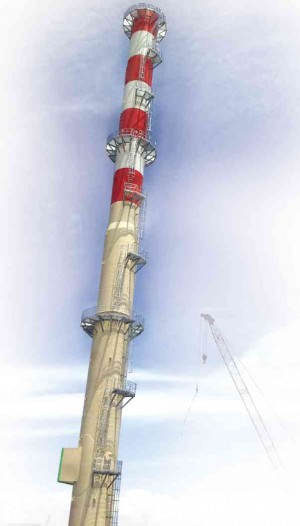More coal power, but cost higher

The smokestack of the coal-fired power plant of the Sarangani Energy Corp. towers over Maasim town. GERMELINA LACORTE/INQUIRER MINDANAO
A few steps away from the Sarangani Bay, the newly built smokestack of Sarangani Energy Corp. towers over the town of Maasim in Sarangani province, rendering minute a host of heavy equipment working hard to finish the plant.
Company officials say the plant will start test-commissioning in the first quarter of this year. They expect it to supply 105 megawatts (MW) of power to the Mindanao grid when commercial operations begin in October.
The facility is only one of at least four that will be running commercially this year to ease the power supply shortage in the Mindanao grid, Romeo Montenegro, director for investment promotions and public affairs of the Mindanao Development Authority (MinDA), said in Davao City.
Also expected to go online in June is the first 300 MW of the 600-MW coal-fired power plant project of the Aboitiz-owned South Therma Marine Inc. in a 60-hectare lot that spans Davao City’s village of Binugao in Toril District and that of Inawayan village of Santa Cruz town in Davao del Sur province.
Another 150 MW will be drawn from the first phase of San Miguel Corp.’s (SMC) coal-fired power plant in Malita town, also in Davao del Sur, in December, and 30 MW more from First Gen Mindanao Hydropower Corp. in Jabona town, Agusan del Sur province.
Stable supply
Mindanao has experienced power outages sporadically since 2010. Although power is projected to be much stable this year, it will not be going any cheaper for consumers, Montenegro warned.
“Coal is cheaper compared with diesel and other fossil-based energy, but it is definitely more expensive than hydro, which Mindanao has been used to,” he said.
Coal normally fetches a price of P6 per kilowatt-hour (kWh)—lower than diesel’s P9-P11 per kWh, but it is costlier than hydropower which costs only P4 per kWh.
Earlier, Vicente Lao, chair of the Mindanao Business Council, said in an interview that the supply of power was expected to stabilize in Mindanao in 2015, but power rates would not be any cheaper than those of other members in the Association of Southeast Asian Nations (Asean).
In fact, Lao said, as Asean integration would commence that year, power would remain the Philippines’ handicap to compete in the fast integrating market.
Currency fluctuations
Jean Lindo, a co-convener of the environmentalist group No to Coal, said coal as a source of power had not been as cheap as people were made to believe. Aside from the threats to health and environment, the price of coal is also subject to fluctuations in foreign exchange rates and the law of supply and demand in the world market, she said.
But Montenegro echoed energy officials’ stand that Mindanao must wean itself away from overdependence on hydropower, which, they said, was vulnerable to fluctuations during long dry spell and the long summer months.
The solution is to come up with an energy mix, which ensures a steady supply of power 24/7, he said.
In its supply-demand outlook, MinDA projected that Mindanao’s power mix was going to rely more on coal and less on hydropower in the next three to five years. It based its forecast on the number of projects already in the pipeline and the expected rate of electricity consumption.
Reliance on hydropower will go down from the existing 50 percent in 2014 to only 29 percent in 2016, while reliance on coal will increase from 14 percent in 2014 to 49 percent in 2016, the agency said.
Moreover, while Mindanao derives more than 56 percent of its energy needs from renewable energy (mainly hydropower) in 2014, this dependence would decline to 33 percent in 2016 because of the sheer number of coal-fired power plants already ongoing, it added.
26 new coal plants
The environment group Philippine Movement for Climate Justice (PMCJ) noted that 26 new government-approved coal plant projects all over the country, made up of 45 coal boilers, were expected to go online by 2020.
More than half of these new plants will be in Mindanao, an island continuing to enjoy cheaper power rates because the bulk of its energy needs come from hydropower, the PMCJ said.
Environmentalists consider the figure alarming, especially at a time when countries around the world are already shifting to renewable energy for their power needs.
“What the Philippines is doing is locking itself to coal dependency in the next 30 to 50 years,” said Aviva Imhof, coordinator of the Pacific Coal Network of the Australia-based The Sunrise Project, in an interview in Davao City last year.
“It’s crazy because there’s the concern about the global increase in coal prices; and if governments agree on climate targets, it will drive up the cost of coal, which consumers will be paying because the (power) generators will pass on the fuel cost to consumers,” she said.